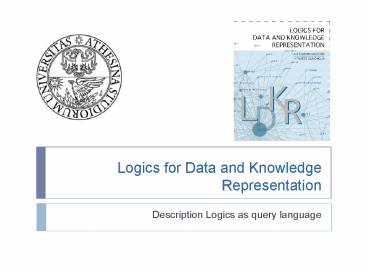Logics for Data and Knowledge Representation - PowerPoint PPT Presentation
Title:
Logics for Data and Knowledge Representation
Description:
Logics for Data and Knowledge Representation Description Logics as query language Outline From Databases to DL From ER diagrams to DL Answering Queries in DL via ... – PowerPoint PPT presentation
Number of Views:84
Avg rating:3.0/5.0
Title: Logics for Data and Knowledge Representation
1
Logics for Data and KnowledgeRepresentation
- Description Logics as query language
2
Outline
- From Databases to DL
- From ER diagrams to DL
- Answering Queries in DL via instance checking
- Answering Queries in DL via instance retrieval
tableaux - Answering Queries in DL via graphical
representation
3
Limitations of databases w.r.t. DL
Employee
Name Role Nationality Supervises
Fausto Professor Italian Rui
Rui Student Chinese Bisu
Bisu Student Indian -
- No negation
- No disjunction
- Ambiguous support for incomplete information
(null values) - The database represents a single model.
- Hence, inference is just model checking.
3
4
Defining a TBox and ABox for a database
Employee
Name Role Nationality Supervises
Fausto Professor Italian Rui
Rui Student Chinese Bisu
Bisu Student Indian -
Individual
Class
Relation
Attribute
TBox Professor ? Employee, Student ?
Employee
- ABox Professor(Fausto), Student(Rui),
Student(Bisu), - Nationality(Fausto, Italian),
Nationality (Rui, Chinese), - Nationality (Bisu, Indian),
Supervises(Fausto, Rui), - Supervises(Rui, Bisu)
4
5
Defining DL theories for ER diagrams
- An ER conceptual schema can be expressed as a DL
theory - The models of the DL theory correspond to the
legal database states of the ER schema. - Reasoning services, such as satisfiability of a
schema or of a logical implication, can be
performed by the corresponding DL theory. - A DL theory allows for a greater expressivity
than the original ER schema, in terms of full
disjunction and negation and entity definitions
by means of both necessary and sufficient
conditions.
6
Define a DL theory for the ER diagram
TBox Person ? Manager ? Employee, Manager ?
Person ? ? Employee, Employee ? Person ?
?income-1.Dollar-quantity ? ?location-1.City Dolla
r-quantity ? Quantity City ? ?is-part-1.Region
7
DL as query language
TBox ABox Child(John, Mary),
Female(Mary) NL Query Who are the individuals
having only female children? DL Query T, A ?
?Child.Female Answer John
- We can think to a database as a DL theory with
one model - ABox services are generally applied to resolve a
query - Complexity may go up to CO-NP complete
7
8
How to use ABox Reasoning Services
ABox Service Description Query
Instance retrieval Given a concept C, retrieve all the instances a which satisfy C w.r.t. the ABox A. A ? C
Instance checking Check whether an assertion C(a) is entailed by the ABox, i.e. check whether a belongs to C. A ? C(a) A ? R(a,b)
NOTE this means that before answering we need to
expand the ABox (w.r.t. the TBox) and reason on
the identified model
8
9
RECALL Reasoning via expansion of the ABox
- Reasoning services over an ABox w.r.t. an acyclic
TBox can be reduced to checking an expanded ABox. - We define the expansion of an ABox A with respect
to T as the ABox A that is obtained from A by
replacing each concept assertion C(a) with the
assertion C(a), with C the expansion of C with
respect to T. - A is consistent with respect to T iff its
expansion A is consistent - A is consistent iff A is satisfiable, i.e. non
contradictory.
9
10
Answering Queries via instance checking (I)
- TBox Horse ? Animal, Mule ? Animal
- ABox Horse(Furia), Parent(Speedy, Furia)
- NL Query Is Furia an animal?
- DL Query T, A ? Animal(Furia)
- YES, in fact the ABox can be expanded as follows
- ABox Horse(Furia), Animal(Furia),
Parent(Speedy, Furia)
10
11
Answering Queries via instance checking (II)
- TBox Horse ? Animal ? ?Mule, Mule ? Animal
- ABox Horse(Furia), Parent(Speedy, Furia)
- NL Query Is Furia a mule?
- DL Query T, A ? Animal(Furia)
- NO, in fact the ABox can be expanded as follows
- ABox Horse(Furia), Animal(Furia),
?Mule(Furia), - Parent(Speedy, Furia)
11
12
Answering Queries via instance checking (III)
- TBox Horse ? Animal, Mule ? Animal
- ABox Horse(Furia), Parent(Speedy, Furia)
- NL Query Is Furia a mule?
- DL Query T, A ? Mule(Furia)
- NO (BY CLOSED WORLD ASSUMPTION), in fact the ABox
can be expanded as follows - ABox Horse(Furia), Animal(Furia),
Parent(Speedy, Furia) - If we drop closed world assumption the answer
should be I DO NOT KNOW
12
13
Answering Queries via instance retrieval
Tableaux (I)
- TBox Horse ? Animal, Mule ? Animal
- ABox Horse(Speedy), Horse(Furia),
Parent(Speedy, Furia) - NL Query Is there any animal which is not both a
horse and a mule, - and is parent of a horse?
- DL Query T, A ? ?Parent.Horse ? ? (Horse ? Mule)
- i.e. is the formula satifiable?
13
14
Answering Queries via instance retrievalTableaux
(I)
- TBox Horse ? Animal, Mule ? Animal
- ABox Horse(Speedy), Horse(Furia),
Parent(Speedy, Furia) - Is ?Parent.Horse ? ? (Horse ? Mule) satifiable?
- ?-rule A ?Parent.Horse(x), ?(Horse ?
Mule)(x) - ?-rule A Horse(Furia), Parent(Speedy,
Furia), (?Horse ? ?Mule)(x) - ?-rule A Horse(Furia), Parent(Speedy,
Furia), ?Horse(Speedy) inconsistent - or
- A Horse(Furia), Parent(Speedy,
Furia), ?Mule(Speedy) consistent
14
15
Answering Queries via graph reasoning
NL Query Does John have a female friend loving a
not female? DL Query ? ? ?FRIEND.(Female ?
(?LOVES.?Female))(john)
15
16
Answering Queries via graph reasoning
NL Query Does John have a female friend loving a
male? DL Query ?1 ? ?FRIEND.(Female ?
(?LOVES.Male))(john)
16
17
Provide the answer for the queries
?
? ? ENROLLED(Mary, cs221) ? ? Grad(peter) ? ?
Grad(Susan) ? ? ? ENROLLED.Grad (ee282) ? ? ?
TEACHES. IntermediateCourse(bob)
? ? Grad ? ? TEACHES.? ? ? Student ? ? ENROLLED.?
17





















![Artificial Intelligence Lecture 8: [Part I]: Selected Topics on Knowledge Representation PowerPoint PPT Presentation](https://s3.amazonaws.com/images.powershow.com/7421234.th0.jpg?_=20151128083)








